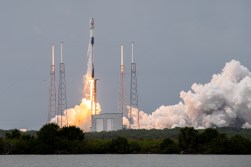Space Development Agency awards $1.3B for hypersonic missile-tracking satellites

The Pentagon’s Space Development Agency tapped L3Harris Technologies and Northrop Grumman Strategic Space Systems to prototype and maintain the Tranche 1 (T1) Tracking Layer of its National Defense Space Architecture.
That Tracking Layer will be comprised of specialized constellations of satellites intended to provide global, nonstop monitoring for conventional and advanced missile threats, including hypersonic systems flying faster than five times the speed of sound.
Via two prototype agreement awards worth a potential combined value of more than $1.3 billion, the prime contractors will supply specific segments of those built-for-space devices, which are slated to begin launching in April 2025.
“Historically, we have not flown satellites that were designed to go after and detect hypersonic maneuvering vehicles,” SDA Director Derek Tournear told reporters during a press briefing on Monday. “It’s important. As you see in the news, our adversaries — so, primarily Russia and China — have been developing and testing hypersonic glide vehicles, these advanced missiles that are extremely maneuverable.”
The tracking layer satellites are “specifically designed to go after that next-generation version of threats out there,” Tournear added, noting that they will enable military personnel to eventually “track and predict the impact of hypersonic weapons throughout the entire flight of the missile.”
SDA’s overarching National Defense Space Architecture is coming together through a layered approach with multiple tranches of system deployments.
Down the line, the architecture is anticipated to feature hundreds of satellites and sensors that will cycle out over the years and ultimately follow targets like missiles and hypersonic vehicles, provide position, navigation and timing in GPS-denied locations, and communicate with technology on ground stations and other spacecraft.
Previously, U.S. architecture beyond Earth “was designed in an environment that was very benign — in other words, an environment that was not threatened at all,” Tournear noted. Now, though, he said space is more challenged and considered a contemporary warfighting domain.
“So, because of that, we had to completely change the way that we do our space architecture,” Tournear said. The idea is essentially that heaps of satellites will be hovering across low and medium Earth orbits in a larger and more complex system that can’t be easily taken down.
This tracking layer marks one major component within that broader national security-focused environment.
Under the new contracts, each company will build a space segment consisting of two planes with seven space vehicles per plane to capture infrared data and support network communications. In total, there will be 28 satellites over four planes for this particular tranche and the companies are responsible for launch services and ground segments for continued operations and sustainment.
“The reason we use four launches is because as we put the satellites in orbit, we put them in slightly different locations. So all of the satellites will be flown at right at about 1000 kilometers, and they’ll all essentially be what we call polar-orbiting satellites, which means they’ll go over the globe from north-to-south, or around the globe that way,” but spaced in four different planes, Tournear explained.
SDA’s awards were made as rapid other transaction prototype agreements.
During the briefing, Tournear confirmed that seven companies competed to be prime vendors — and there were some new subcontractors in the mix, compared to past tranches. L3Harris will deliver “all 14 of their satellites for right at $700 million,” or about $50 million apiece, he said, and Northrop Grumman will deliver its cadre of 14 at roughly $617 million, or around $44 million per satellite.
Notably, these two prototype agreements were finalized on a relatively quick timeline for the government and come as America’s competitors are refining hypersonic missiles capable of low-earth orbit.
Service members could track the trajectory of warheads on rockets for ballistic missiles used in conflicts over the decades. But now, Tournear noted, when ultramodern missiles reach hypersonic speeds, they can use aeronautical forces to maneuver and are near-impossible to pinpoint and follow.
Currently, the military has limited capabilities to perform “that tracking aspect,” SDA’s director explained.
“Clearly we don’t have zero capability to do tracking. But most everything is designed around doing what we call ‘missile warning,’ which is initial launch. The satellites that we’re going to be launching and fielding can do that complete missile warning and missile tracking around the globe for as many missiles as could be launched against us,” Tournear said. “So, we will not only be able to do the old-school mission of missile warning, detect the launch and predict the impact point, but we’ll be able to detect it as it’s maneuvering and changing its impact point and be able to send that down and be able to tell an interceptor exactly where that missile is headed.”




